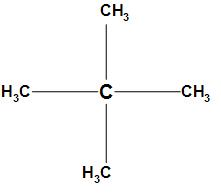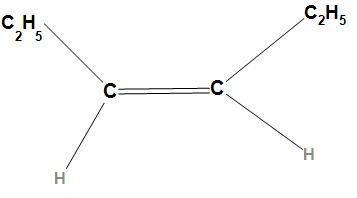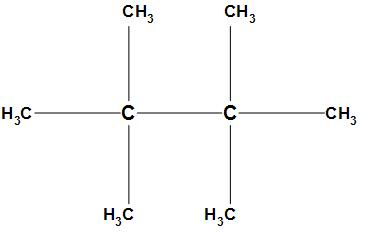
The molecule that have dipole moment:
A. 2, 2-dimethyl propane
B. Cis-3-hexene
C. 2,2,3,3-tetramethyl butane
D. None of these
Answer
556.5k+ views
Hint: Dipole moments occur in any system where there is a separation of charge. They can occur in ionic bonds as well as covalent bonds. It arises due to the electronegativity difference between the bonded atoms. The dipole moment in a bond is the measure of the polarity of the chemical bonds between two atoms in a molecule. The concept involves the separation of the negative and positive charges in a bond. It has a magnitude and direction due to which is a vector quantity. For example, showing the dipole moment of $HCl$ (hydrochloric acid) in the diagram below:
$^{\delta + }H - C{l^{\delta - }}$
Complete step by step answer:
The first option is 2, 2-dimethyl propane. The structure of 2, 2-dimethyl propane is

In the structure of 2, 2-dimethyl propane the $s{p^3}$ hybridized carbon which is electropositive will attract the electrons from all the methyl groups towards itself and due to which a dipole is created. Hence, the opposite dipole moments will cancel each other and the resultant dipole moment will be zero. Thus, 2, 2-dimethyl propane has no dipole moment.
Second option is Cis-3-hexene. The structure of Cis-3-hexene is

In the structure of Cis-3-hexene, the $s{p^2}$ hybridized carbon which is more electropositive than the $s{p^3}$ hybridized carbon will attract the electrons towards itself due to which a dipole will be created. Hence there is no opposite dipole moment, it will not cancel each other and hence the resultant dipole moment will not be zero. Thus, Cis-3-hexene has a dipole moment.
The third option is 2, 2, 3, 3-tetramethyl butane. The structure of 2, 2, 3, 3-tetramethyl butane is:

In the structure of 2, 2, 3, 3-tetramethyl butane the $s{p^3}$ hybridized carbon which is electropositive will attract the electrons from all the methyl groups towards itself due to which a dipole will be created. The opposite dipoles will cancel each other and the resultant dipole moment will be zero. Thus, 2, 2, 3, 3-tetramethyl butane has no dipole moment.
After discussing we can conclude that Cis-3-hexene has a dipole moment.
So, the correct answer is Option B .
Note: Cis-3-hexene is symmetrical disubstituted alkene. It is prepared by the hydroboration of 3-hexyne which on protonolysis gives the final Cis-3-hexene. The $s{p^2}$ hybridized carbon in Cis-3-hexene is electropositive.
$^{\delta + }H - C{l^{\delta - }}$
Complete step by step answer:
The first option is 2, 2-dimethyl propane. The structure of 2, 2-dimethyl propane is

In the structure of 2, 2-dimethyl propane the $s{p^3}$ hybridized carbon which is electropositive will attract the electrons from all the methyl groups towards itself and due to which a dipole is created. Hence, the opposite dipole moments will cancel each other and the resultant dipole moment will be zero. Thus, 2, 2-dimethyl propane has no dipole moment.
Second option is Cis-3-hexene. The structure of Cis-3-hexene is

In the structure of Cis-3-hexene, the $s{p^2}$ hybridized carbon which is more electropositive than the $s{p^3}$ hybridized carbon will attract the electrons towards itself due to which a dipole will be created. Hence there is no opposite dipole moment, it will not cancel each other and hence the resultant dipole moment will not be zero. Thus, Cis-3-hexene has a dipole moment.
The third option is 2, 2, 3, 3-tetramethyl butane. The structure of 2, 2, 3, 3-tetramethyl butane is:

In the structure of 2, 2, 3, 3-tetramethyl butane the $s{p^3}$ hybridized carbon which is electropositive will attract the electrons from all the methyl groups towards itself due to which a dipole will be created. The opposite dipoles will cancel each other and the resultant dipole moment will be zero. Thus, 2, 2, 3, 3-tetramethyl butane has no dipole moment.
After discussing we can conclude that Cis-3-hexene has a dipole moment.
So, the correct answer is Option B .
Note: Cis-3-hexene is symmetrical disubstituted alkene. It is prepared by the hydroboration of 3-hexyne which on protonolysis gives the final Cis-3-hexene. The $s{p^2}$ hybridized carbon in Cis-3-hexene is electropositive.
Recently Updated Pages
Master Class 11 Business Studies: Engaging Questions & Answers for Success

Master Class 11 English: Engaging Questions & Answers for Success

Master Class 11 Computer Science: Engaging Questions & Answers for Success

Master Class 11 Social Science: Engaging Questions & Answers for Success

Master Class 11 Maths: Engaging Questions & Answers for Success

Master Class 11 Biology: Engaging Questions & Answers for Success

Trending doubts
Differentiate between an exothermic and an endothermic class 11 chemistry CBSE

10 examples of friction in our daily life

One Metric ton is equal to kg A 10000 B 1000 C 100 class 11 physics CBSE

Difference Between Prokaryotic Cells and Eukaryotic Cells

State the laws of reflection of light

Explain zero factorial class 11 maths CBSE




